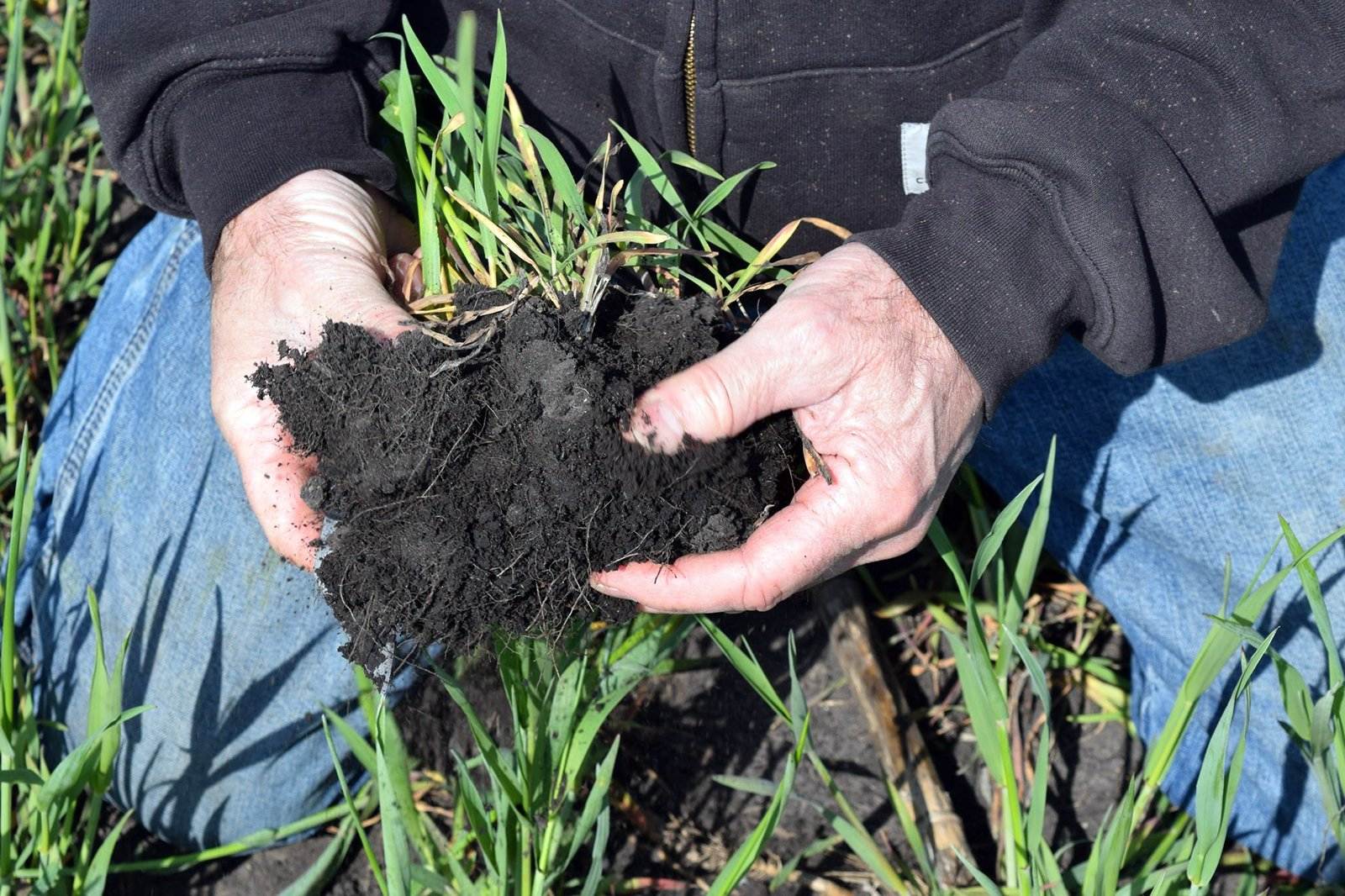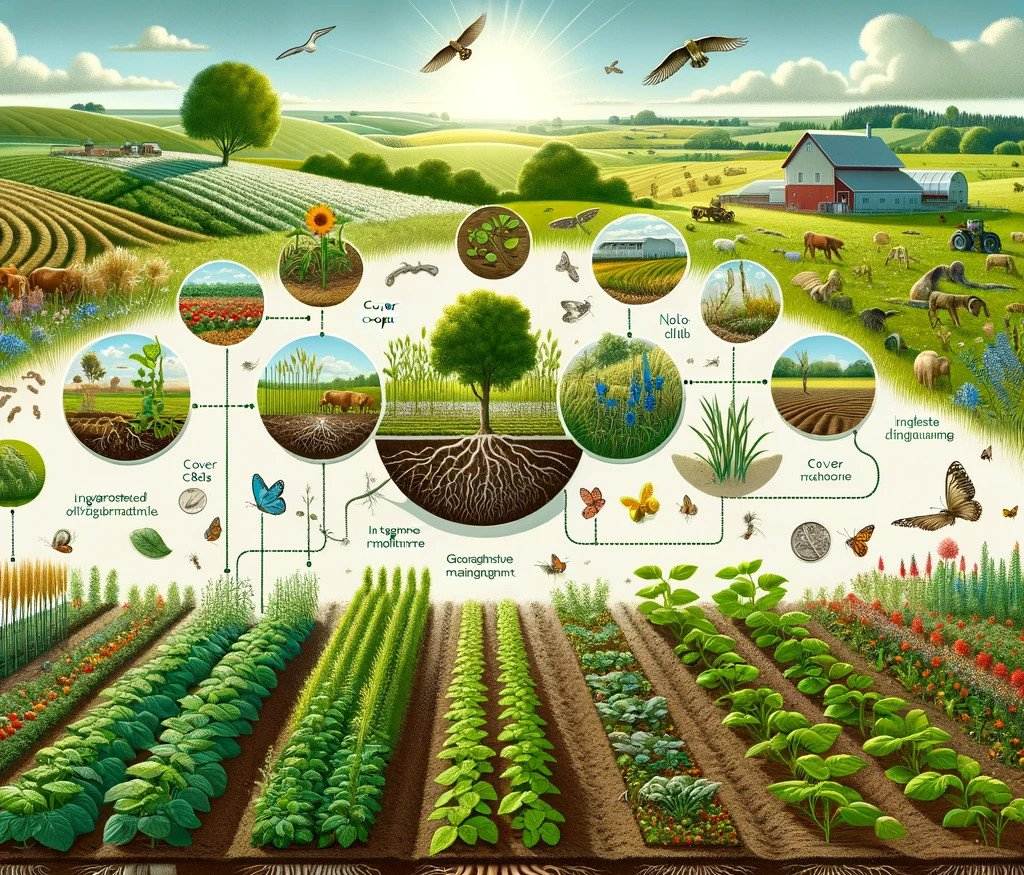Boosting the health of your land is like unlocking a treasure chest of possibilities. It’s all about nurturing the soil so it can support vibrant crops while improving organic matter.
One popular technique is cover cropping, where farmers plant specific crops in off-seasons to shield the soil and enhance its richness.
Another effective strategy is crop rotation, helping to manage pests while cycling nutrients through the ground.
These methods are fantastic for soil restoration and pave the way for a sustainable farming future that benefits both the earth and the next generation
Understanding Soil Health Indicators
Every farmer wants their land to thrive and be as productive as possible. Keeping tabs on various signs in the earth below can offer insights into how well your crops might perform.
The health of the soil microbiome, for instance, is closely tied to how effectively nutrients circulate within the ecosystem.
Observing the amount of organic matter present is particularly useful, as it helps your land retain vital nutrients over time.
Regular testing can highlight how your practices align with principles of agroecology, guiding your choices in composting and crop selection. Paying attention to these signs can reshape your entire approach to farming.
Following the best regenerative agriculture techniques not only boosts yields naturally; it also encourages a deeper connection to the land. Improving your practices can lead to healthier, more vibrant soil microbiome, enhanced agroecology, and the successful integration of composting, holistic management, and permaculture principles.
Importance Of Organic Matter In Soil
For farmers and gardeners alike, the health of the soil is like the heartbeat of a thriving ecosystem. Organic matter, which consists of decomposed materials from plants and animals, is a key player in this picture.
Think of compost and manure as the nutrition your soil needs to stay vibrant and productive.
Among the many perks of incorporating organic matter is the improvement of soil structure that promotes nutrient cycling.
This enhancement not only aids in aeration but also supports water retention, ensuring your crops can access the moisture and air they require to thrive.
By boosting nutrient availability, these materials release essential elements gradually, keeping your plants well-fed and happy.
Research has shown a direct correlation between increased organic content and crop yields. Farms embracing these regenerative practices often witness not just improved biodiversity and soil erosion control, but also enhanced nutrient cycling and sustainable farming outcomes.
| Benefit of Organic Matter | Impact on Soil Health |
|---|---|
| Improves soil structure | Enhances nutrient cycling |
| Promotes aeration | Supports water retention |
| Boosts nutrient availability | Increases crop yields |
| Encourages biodiversity | Reduces soil erosion |
How Cover Cropping Enhances Biodiversity
If you’ve ever wanted to elevate the health of your farm, consider the magic of planting diverse crops in between your main harvests. These special plants act as living blankets, enhancing soil structure and providing a safe haven for the creatures that keep your ecosystem balanced.
By adding organic matter, they enrich soil fertility, which is super important for nutrient cycling.
This practice is also a smart way to improve water retention, making sure your crops have what they need even when the skies don’t cooperate.
Picture a lively landscape filled with beneficial insects, all working hard to boost your farm’s productivity. It’s a simple change with a big impact!
Picking the right cover crop is essential. It should fit well with your local climate and soil characteristics while contributing to ecofriendly practices such as agroforestry that enhance soil fertility, improve soil structure, and increase water retention.
Benefits Of Crop Rotation For Soil
Taking care of your garden is like nurturing a friendship; it thrives with attention and care. Ever thought about how altering your planting routine could transform your soil? When you switch up your crops, you’re not just giving your plants a new environment, but you’re also boosting the health of your earth.
For example, legumes do wonders by enriching the soil with nitrogen, while plants with deep roots help to break up any stubborn, compacted layers.
Overall, adopting practices like land stewardship, resilience building, biological pest control, carbon sequestration, and mulching can significantly enhance soil health and nutrient availability.
- Crop rotation can improve soil fertility and structure.
- Legumes can increase nitrogen levels in the soil, promoting healthier plant growth.
- Deep-rooted plants help aerate the soil and alleviate compaction.
- Practices like mulching can enhance moisture retention and reduce erosion.
Practices For Effective Soil Erosion Control
Taking care of the soil is essential for keeping your land healthy and productive. One way to help is through the practice of cover cropping, where you plant specific crops to not only protect the earth but also to enrich it.
These crops improve the soil structure and moisture retention, which every farmer knows is key for thriving plants.
Then there’s contour farming, where you align your planting rows with the natural curves of the land.
This method reduces runoff and promotes an ecological balance, making your farming efforts yield better results.
Don’t overlook the benefits of strip cropping; it effectively manages erosion while significantly boosting soil health.
It’s a clever strategy to keep your fields productive and flourishing. You might even consider incorporating practices such as intercropping, integrated pest management, rotational grazing, and soil amendment to achieve a sustainable ecological balance.
Role Of Composting In Soil Restoration
Think of enriching your land as a way to breathe life back into it. When you work with organic materials, you’re not just enhancing the overall quality of the ground; you’re actually setting the stage for regeneration.
This practice boosts the organic matter, which has a massive impact on nurturing plants.
Healthier soils naturally lead to increased nutrient density in your crops, paving the way for more robust and bountiful harvests.
What’s fascinating is how this method also builds a better soil structure, improving water retention and tackling erosion effectively.
You’d be amazed at how this encourages beneficial organisms, weaving a vibrant ecosystem beneath the surface. All these elements play a part in sustainable pasture management, keeping everything in harmony while ensuring long-term productivity.
Through the implementation of polyculture, effective pasture management, and a focus on nutrient density, we can enhance food sovereignty and promote regenerative landscapes.
Soil Enrichment and Regeneration
- Organic materials enhance soil quality and boost organic matter, leading to healthier plants.
- Improved soil structure increases water retention and reduces erosion, promoting a sustainable ecosystem.
- Higher nutrient density in crops results from healthier soils, contributing to more robust harvests.
- Effective pasture management fosters harmony in the ecosystem, ensuring long-term agricultural productivity.
Exploring Soil Microbiome And Nutrient Cycling
Have you ever considered how much life exists right beneath our feet? The ground we walk on is teeming with tiny organisms that significantly impact our farming success. Did you know a thriving community of microbes serves as a strong indicator of soil health indicators? These small players are busy breaking down organic matter and cycling nutrients, providing essential support for plants.
For example, bacteria and fungi are fantastic decomposers, returning crucial nutrients to the earth.
Incorporating practices like organic farming not only boosts these microbial communities but also enhances the overall ecosystem. Transitioning from the role of composting in soil restoration, we can appreciate how holistic management supports resilience building in soil health indicators, organic farming, precision agriculture, watershed management, and community-supported agriculture.
How Holistic Management Supports Resilience Building
Farmers everywhere are realizing the power of a holistic approach. It encompasses the entire ecosystem of a farm, linking soil testing, biodiversity, and economic viability in an inseparable dance.
For instance, soil testing isn’t merely about checking nutrient levels; it reveals how these nutrients engage with both the micro and macro life in the soil.
Healthy soil is a thriving habitat for earthworms and mycorrhizal fungi, two key players that boost plant growth.
Together, these relationships create a farming system brimming with resilience that can handle whatever nature throws its way.
Land conservation practices, like rotational grazing, do wonders for soil structure and erosion control. These practices help to enhance soil health by promoting biodiversity, improving nutrient availability, and fostering sustainable land management.
Conclusion
Our journey through holistic management highlights the many ways we can embrace farming’s future with open arms. Focusing on soil biology not only elevates crop diversity but also strengthens the entire ecosystem.
By putting soil health at the forefront, we can significantly increase yield and promote sustainable land use practices.
This commitment plays a crucial role in retaining soil carbon, which is indispensable for mitigating greenhouse gas emissions.
As we look ahead, innovative strategies like companion planting can take our efforts to the next level. Let’s cultivate a farming community where sustainability and resilience go hand in hand, ensuring a thriving environment for all









